The aim of this guide is to help store owners how to find eCommerce designers using a high-quality outsourcing marketplace so you can select the best one that suits your store.
“Outsourcing” and “freelancing” are two hugely popular buzzwords that have apparently revolutionised business in recent years. Don’t believe the hype. Instead, think of “outsourcing” as simply hiring someone for a job you need to be done.
If your stove breaks, you tend to “outsource” to a professional repair person.
The process you would generally go through is to either find a repairman through word-of-mouth recommendations or via a business directory.
Once you found someone you’d call them up, tell them what you want to be done, ask them how much and when it can be done by. You both agree on a price and the outcome of the work.
You then rely on the repairman to do the job correctly, without you needing to get heavily involved.
Put in these terms “outsourcing” should seem far more accessible and easy for you to manage. You are simply hiring an experienced professional, in this case a website designer, to complete a job.
You may feel that eCommerce or design technology is more intimidating than merely fixing a stove, but at the end of the day you are the customer and you know what you need to be done, and the money is coming from your pocket.
The real revolution, implied by the buzzwords, has been the creation of virtual marketplaces where buyers and sellers can find each other. These are often referred to as freelancing sites, and there is an abundance of them.
Step 1: Find An Outsourcing Marketplace
There are several high-quality outsourcing marketplaces such as oDesk.com, scriptlance.com, elance.com, 99designs.com and freelancer.com. There are many many more. You can use any outsourcing marketplace that you prefer and apply the same principles from this workbook to each of these systems.
We use oDesk.com for the reason that the contractors are monitored as they work. Every few minutes a snapshot of a worker’s computer is uploaded to your oDesk account.
This is called a Work Diary. You can just about ‘watch’ as the contractor works on your job.
This creates a sense of trust. As an employer you can see if the contractor is goofing off on Facebook and still charging money to your account.
You can also see an indication of activity by the number of keystrokes and mouse movements made while working.
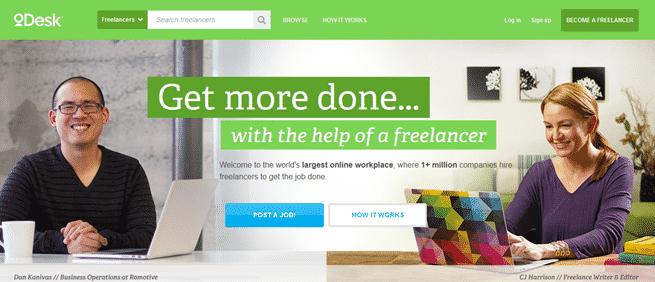
For several years we’ve found the quality of oDesk contractors to be good enough for the project work we need to be completed. Many contractors have multiple accounts – one on each marketplace.
Often you’ll find the same contractors on all the marketplaces mentioned above, for the same rates, but the marketplaces will have different services and tools.
Step 2: Start Working With oDesk
Signing up for an account with oDesk is FREE and easy. Simply visit www.odesk.com and then follow the prompts. A few things of note:
- In order to make payments to a contractor you will need to verify that your payment method is reliable. oDesk will ask for your credit card number and will make two small charges (usually around $1 to $2) to your credit card. These amounts act as a unique verification number, and once you have them, are copied into your oDesk account. This then makes your oDesk account “live”.
- The charges usually take at least 1 to 2 days to show up in your credit card account (online banking version) so make sure you don’t wait too long to sign up for an account. Without a verified payment method you will not be able to attract as many contractors to your project, and you won’t be able to immediately start the contract when you do find someone you really want to work with.
- Whilst there are no setup fees within oDesk they make their money by charging a 10% surcharge on all transactions. If a contractor charges $13.50/hour then the final rate you pay will be $15.00/hour. Many people are tempted to circumvent the oDesk system in order to save 10% on development costs. I would suggest, especially if you are a novice employer, that you stay within the oDesk marketplace.
- For each hour that a contractor works they are paid, from your credit card. Sounds like an invitation to make you go broke! However, you can limit the number of hours that can be worked by a contractor in a week. For all new contractors I start with no more than 2 to 4 hours a week. If their cost is $20.00 hour then the most I will lose is $40 to $80. This is not a significant amount if there is a dispute.
Step 3: Create Your First Job In oDesk
As simple as it is to create a new job and let the oDesk system automatically find contractors, I would recommend against this approach.
You will end up with contractors who have chosen you – this does not allow you to control who you want to work with.
1. You will have already created your oDesk account and will either have verified your payment details or will be waiting for the verification numbers to show in your credit card account.
- Login to your oDesk account.
- Click the Post a job button.

2: You’ll now be presented with a screen with several fields that require text. Fill each field in with as much information as you feel is necessary. You can edit the job posting later on, if you do need to change anything.
Category & Sub-Category:
- Choose the categories that you feel fits best with the role you are trying to fill. Many oDesk contractors allocate themselves to multiple categories. So, even if you are looking for a designer with a bit of web development skill you’ll still find them in both the Web Design and Web Development categories. Contractors add themselves to many categories so they receive all new job notifications, regardless of whether they are actually qualified to complete the work or not.
Job Title:
- This is probably the most important piece of information you need to consider when placing your job in oDesk, or any other outsourcing marketplace.
- You can create a really wild and interesting looking job title to catch a contractor’s attention or go for something plainer. For example, “!!VIBRANT, ENERGETIC DESIGNER NEEDED FOR SNAZZY STORE DESIGN!!” or “Graphic Designer with eCommerce Design Experience”
- You can post multiple job listings if you feel that your first job listing isn’t attracting the quality of employees that you were hoping to find.
- Recruitment companies who use oDesk tend to use literal and traditional job role titles, but smaller employers range from describing the job role to adding enticements. The latter usually use the Job title field to describe the job, rather than to describe the type of person they are seeking.
- Get a feel for how employers, who have spent the most money, and have the highest rating, write their job titles.
- Some employers will include the budget for the job, whether they need a beginner or expert, and even sometimes whether there is a bonus involved. This can be a good way of attracting employees if you are a new oDesk employer.
Job Description:
- This is obviously the place for you to describe the job that you require completed. But keep in mind that you will have additional opportunities to explain details to contractors before you hire them. You only need to place in enough information to give contractors a good idea of the work that needs to be completed, and whether they can see themselves as appropriate to the task.
- I personally tend to keep my own job descriptions very short and to the point, with a minimum of detail. This allows me to maintain privacy regarding my business and own processes.
- Look through how other employers write their job descriptions, by clicking on the job titles. Read at least 10 to 20, in the category that you want to post into, and you’ll get a feel for how the most experienced employers post their jobs.
Skills Required:
- Adding a list of required skills helps contractors to determine if the task is right for them.
- Some oDesk contractors auto-reply to any and all job posts, literally within seconds publication. Adding a list of required skills can allow you to filter these people out.
Job Type:
- This can be a tricky choice to make. On the other hand, you will feel protected if you choose a fixed price for your project. But if you bid too low then higher quality contractors may ignore your job request. If you bid too high, then you may be flooded with opportunists looking for the work.
- A fixed price job doesn’t allow much room for changes to the original job request. This is particularly important – to have the ability to change your mind – if you need design work completed.
- Choosing to pay by the hour allows all contractors to quickly submit their proposal for your project, without first having to worry and work out whether you have allowed enough money (fixed price) for them to complete the work. oDesk has a ‘pay guarantee’ for workers, which means that your credit card is deducted for any work they do on the project. This provides reassurance to contractors and they are more likely to work on hourly paid projects.
Estimated Duration & Workload:
- For these fields I usually choose one of the smaller selections. It is not often that a project will continue for longer than a few weeks.
Job Visibility:
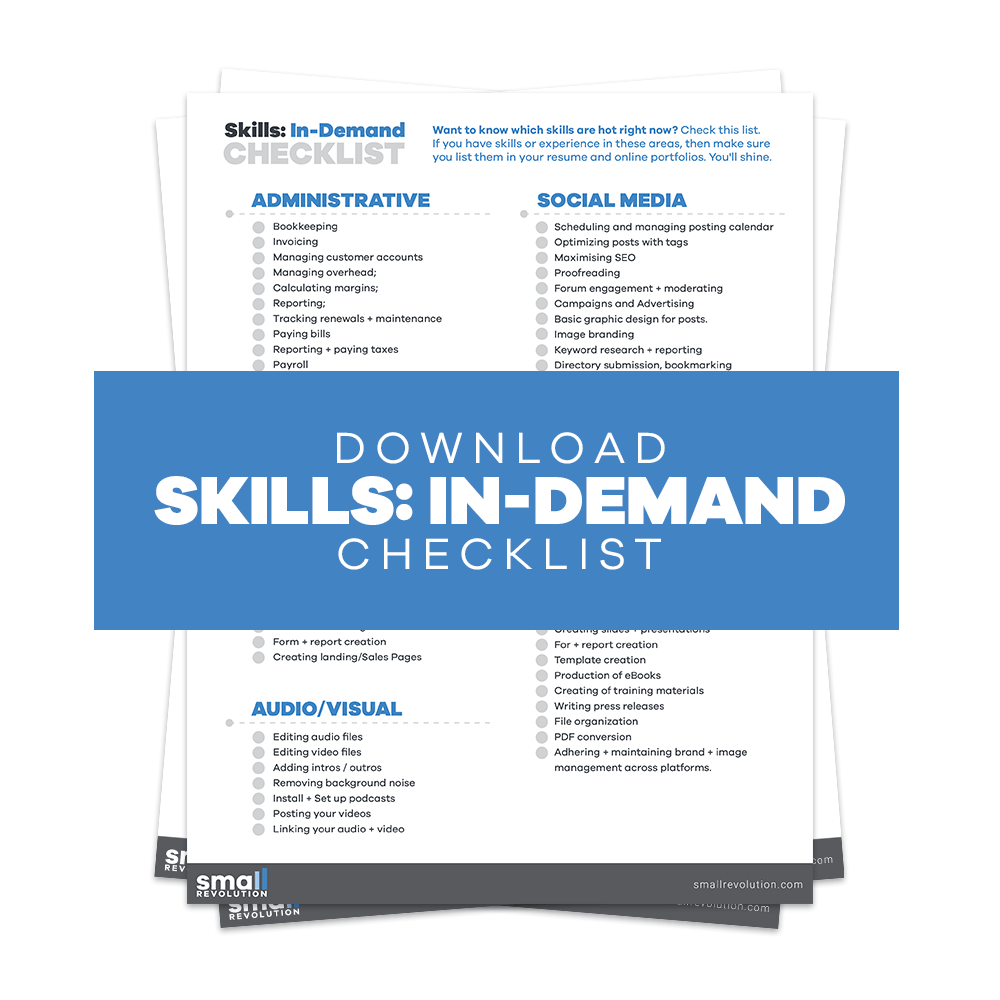
- If you choose to make a project visible then you will usually be flooded with responses from eager contractors. The downside to all this attention is that you will need to work through all the applications to decide who is suitable and who is not. Sometimes too many applications wastes time.
- If you are a new oDesk employer then it’s a good idea to make the project publicly visible. I have often found good contractors who applied, and who were completely new to oDesk, quite by chance.
- You can choose to make the job private and this will allow you to hand-pick applicants. This weeds out many time-wasters, but will also reduce the number of new contractors you might be able to find.
Attachment:
- Sometimes you may like to add some rough sketches of your own ideas or sample documents. This gives contractors a better idea for the scope of work that is required.
- Keep in mind that the attachment must be under 2mb.
Estimated Start Date:
- I usually leave this at the default date, which is ‘tomorrow’. If it will take me longer to decide on a candidate it can be useful to extend the start date to allow some wiggle room.
Preferred Qualifications:
- Not every contractor on oDesk will have added enough data to the oDesk system for the Preferred Qualifications section to be useful. For example, a web developer may not use the inbuilt oDesk portfolio tool. Instead they may have provided a link to their external portfolio. The “Preferred Qualifications” tool is not very useful, and I generally ignore it.
3. Review your job posting and then approve it for publication.
Step 4. Start Shopping For Contractors
Now this is the fun part! This link will send you to a default “find contractors” page. In the right side column you’ll be able to filter your search requests to find the exact contractor you should be working with.
Searching out a contractor means you have more control over whether they are truly suitable for the task at hand, or not.
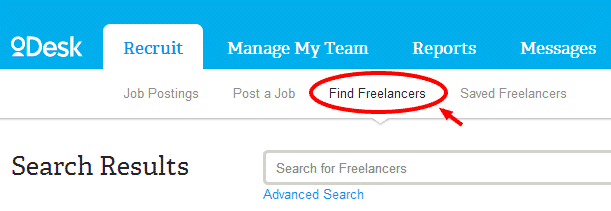
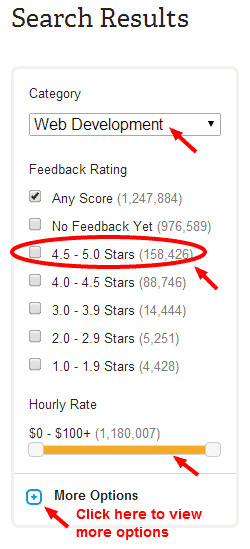
Categories & Sub-Categories:
- Choose the Category and at least 1 or 2 sub-categories. Remember that contractors will sometimes place themselves in more than one category. Choosing multiple categories ensures you find all the contractors you need.
Feedback:
- Always choose contractors with 4.5 to 5.0 feedback ratings. There is an unspoken etiquette that if a contractor does a reasonably good job then they will be given a high score. Only the absolute worst contractors are given scores lower than 4.5.
Hourly rate:
- You can choose your minimum and the maximum hourly rate you wish to pay. Choose a minimum of $5/hour for lower-skilled work (data entry, virtual assistants) and a minimum of $15/hour for higher-skilled work (graphic designers, web programmers).
- The above minimums are based on our experience in finding good quality workers – these are people who provide good quality work and value their time accordingly. For example, a virtual assistant who charges less than $5/hour has probably not in the oDesk market place for very long or provides low-quality results.
- For lower-skilled workers we generally use a maximum of $15/hour as this catches anyone who charges $11/hour. And for higher-skilled workers I move the slider to the $40/hour mark.
- Some workers who are more in demand will inflate their prices to reduce the number of employer enquiries (and time-wasters) that they receive. However, when you contact them directly you can often negotiate a lower rate, more in line with the rest of the market.
- To change the minimum slide the left square to your right, and to reduce the maximum slide the square on the right over to the left.
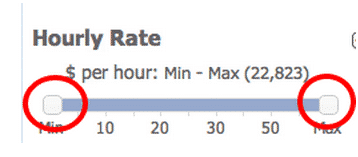
Minimum Hours Billed:
- Some of the best employees we have found had only worked a few hours. They were new to oDesk, but had been working in their industry for several years. So, play around with this particular setting to find oDesk contractors who have long service history and also employees who are only new.
Tests:
- We use the tests if we want to find contractors with particular technical skills such as HTML, CSS or experience in particular technologies such as PHP. oDesk allows contractors to undertake a test and then be given a score and percentile rating.
- Some oDesk workers (particularly agencies) will collude so that all their workers receive a high score. If a worker is an individual then you can usually rely on their score being reasonably accurate. There is, however, no guarantee that they haven’t had help in ‘gaming’ their test scores.
- Take the test results with a grain of salt. A contractor can be technically top of the class, but never complete work on time.
Location:
- This is a very important choice when considering time zones. We are located in Australia, so always choose East Asia and Eastern European selections. East Asians are in the same time zone so we can collaborate on projects in real-time. Eastern Europeans are in our opposite time zone and will complete work overnight.
- There are many brilliant and talented people all around the world, but in our experience the best technical developers and designers tend to be in Eastern Europe. The best virtual assistants, customer service support and data entry people tend to be most affordable in South East Asia.
Contractor Type:
- Your options here are between Agencies (many people run by managers, sometimes real-world companies) and Individuals.
- If you need additional hand-holding then choose an Agency. They will usually offer you one point-of-contact as a liaison. This person is usually not the one who will actually do the work for you – they may be more akin to an office manager or client account manager. They may also be the owner of the company. All your contact will go through one manager.
- Client account managers are usually non-skilled (in terms of the work you require) and will act as an intermediary. Sometimes, if you are dealing with agencies in non-English speaking countries, the client account manager will be chosen because are the most competent English speakers. In this case, they are essentially acting as translators for you and the worker.
- Owners of companies are usually good sales people. You will feel comfortable with them as they are usually very experienced and will give you confidence that your project will go according to plan. If the owner is not always involved then your project may go off track. Owners may get your project started and then hand you over to a subordinate. If this is not your preference, let them know upfront.
- If you choose an agency and are paying on an hourly basis, you will not only pay for the job to be completed by the skilled worker, but you will also be charged for the manager’s time. Be aware of the additional costs that are attributed to the management part of the service. Good service is worth paying for, but be very clear as to your expectations as to what the service should add to the project in terms of value.
- Choosing an Individual means you will have a direct relationship and communication path with the person who is completing your job. You may feel more in control of the entire job process if you deal with just an individual. There will be no intermediary or translation.
- Individuals don’t have additional resources to rely on such as translators. If you don’t speak the same language as your worker then it’s your responsibility to ensure that the level of English (or common language) that you use is easy to understand.
- Individuals will have more time pressures placed on them than agencies. An agency can shift the work required around in their team, in order to get the project completed on time. Using an individual means that your project will have a linear process – one step after the other. You will need a little more time if dealing with an Individual as they will have other clients also wanting their attention.
Latest Activity:
- Always choose 0 – 15 Days. This means that the contractor has recently been active on oDesk, and will be more likely to respond to your request.
Step 5: Review Contractor Profiles
You will now have a reasonably long list of possible candidates from which to choose for your next project.
To review the contractor profiles, without losing your search preferences, right-click on their name and open in a new tab or window. This step will take at least an hour or two of your time if you are thorough.
Step 6: Contact Prospective Contractors
Make contact with prospective contractors by clicking on the CONTACT button in their profiles. This will allow you to send an initial email contact.
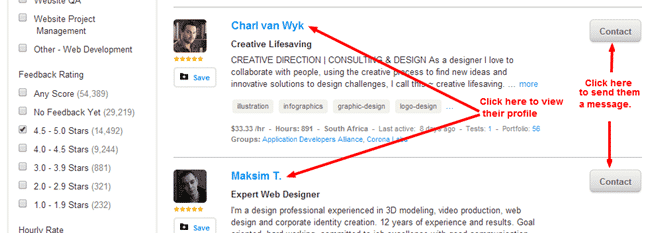
Choose more than 1 contractor, and try to make a note of which ones you liked best. It can be difficult to remember why you decided to choose one contractor over another when their replies come flooding back into your inbox.
Following the above process will help you to make the most from oDesk.
Final Checklist
To give you a short summary of what needs to be done here is a short checklist so everything can sink in.
- Create an account in oDesk so you can use it as an outsourcing marketplace.
- Create a comprehensive and particular job post and post it in oDesk.
- Find contractors using oDesk’s Search Options.
- Then review contractors profiles.
- Lastly, contact your prospected contractors to see if they are fit for the job.
You need this how-to guide to get you started on building your eCommerce store with the help of credible and high-quality eCommerce designers.
With oDesk as your outsourcing platform, you’ll be able to monitor your employees as well as communicate with them and do the work together efficiently.
Photo by peoplecreations / CC BY

